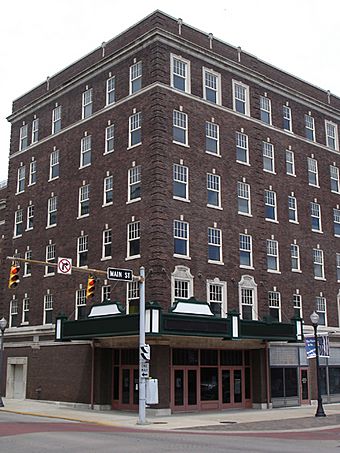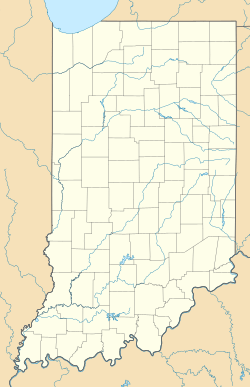Victory Theatre facts for kids
Quick facts for kids |
|
|
Victory Theater and Hotel Sonntag
|
|

Front and side of the theater
|
|
| Location | 600–614 Main St., Evansville, Indiana |
|---|---|
| Area | Less than 1 acre (4,000 m2) |
| Built | 1921 |
| Architect | J.E.O. Pridmore |
| MPS | Downtown Evansville MRA |
| NRHP reference No. | 82000124 |
| Added to NRHP | July 1, 1982 |
The Victory Theatre is a large performance hall in Evansville, Indiana. It has 1,950 seats, making it a great place for many shows. Today, it is the home of the Evansville Philharmonic Orchestra. It also hosts local ballet and modern dance groups, theater companies, and touring shows that travel to different cities.
Contents
History of the Victory Theatre
The Victory Theatre first opened its doors on June 16, 1921. When it was new, it could seat 2,500 people! It was part of a bigger building complex that included the Sonntag Hotel. A man named Marcus Sonntag and his partners helped organize the building of this theater. They hired the Hoffman Construction Company to build it. The theater was quite modern for its time, even having air conditioning that used large blocks of ice to keep audiences cool.
Early Entertainment and Changes
In its early days, the Victory Theatre offered a variety of entertainment every day. You could see four different vaudeville acts, which were like short variety shows with singing, dancing, and comedy. There was also a movie, a comedy routine, live organ music, and a ten-piece orchestra playing music.
In 1926, a big movie company called Loews Theatres took over the Victory. They renamed it Loew's Victory. In 1928, this theater showed Evansville's very first "talking picture," which was a movie with sound! It was an epic film called "Tenderloin." Later that same year, "The Jazz Singer," starring Al Jolson, became the first full-length movie with sound shown in the city.
Closures and Reopening
The Loew's Victory Theatre closed its doors in 1971. It later reopened as the independent Victory Theatre, but it was divided into three smaller movie screens, called a triplex. However, this version of the theater closed again in 1979.
After being closed for many years, the theater was given a huge makeover. It was restored to look like its original grand design. This big renovation cost $15 million and was completed in 1998, when the Victory Theatre reopened once more.
Design and Special Features
The Victory Theatre was designed by an architect named John Pridmore from Chicago. The outside of the building looks simple, like many other commercial buildings from that time. However, the inside of the auditorium, where the audience sits, is much more fancy and decorated.
The stage at the Victory Theatre is very large. It is 68 feet (21 m) wide and 82 feet (25 m) deep. When it was built, it was one of the biggest stages in the entire Midwest region of the United States! Because of its historical importance, the Victory Theatre was added to the National Register of Historic Places in 1982.
Today, the City of Evansville owns the Victory Theatre. It is managed together with The Ford Center by a company called VenuWorks.


